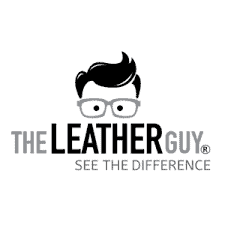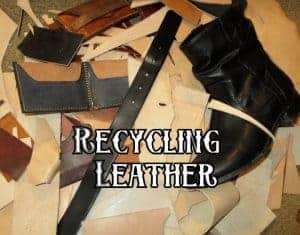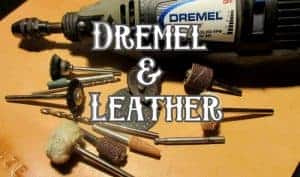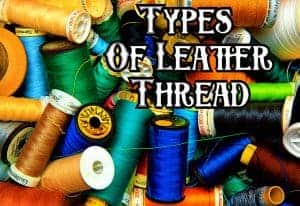
How to Buy Leather – Leathercraft Buying Guide
Buying leather can be very difficult if you are new to leather crafting or even if you have some experience working with leather. It can become very confusing when trying to find the right kind of leather that fits for your specific projects.
So in this guide on how to buy leather I am going to go over where to buy, what part of the leather hide you want to look for, determining grades of leather and a general overview on what to look for when purchasing leather.
To start we should begin on where to buy that fits the amount and type of leather you are looking to buy.
Where to buy leather
Determining where to buy your leather can be a bit overwhelming since there are many places online that sell leather. But to begin you may want to start somewhere where you can go and look at the leather in person.
Brick and Mortar Stores
There are a couple big name retail stores you can buy leather from such as Tandy Leather and Hobby Lobby.
Now there are some shops depending on the area that you live in that offer great selection of leather. But these two places are pretty common at least throughout the United States.
Tandy Leather is great to go in, see and feel different hides and sort through some starter tools. But since they have a local shop, you end up paying a bit extra per hide.

From my experience though, the workers are usually pretty knowledgeable and will give you some good advice on the type and size of hide you want to buy for your projects.
But if you do enough of your own research you will have a pretty basic idea to be able to buy online with confidence. And for the same price you may spend in Tandy, you will be able to get a better quality leather on some of the sites I will talk about further down.
They also don’t really sell smaller than half a hide which may be intimidating if you want to just try out leather working. The smallest amount is usually a belly and a 12″ x 12″ square slab.
So you will end up buying a bigger piece of hide for a little bit of a higher price, but it is great that you can go in and actually see and feel the hide you will be buying.
Hobby Lobby is sort of a last minute alternative. Now I have used their leather before and have had mostly a good response with it. They also always have a 40% off coupon you can use at the checkout which will help a bunch if you want to get a feel for leather crafting.

For the most part they usually have a thicker 6-8oz leather, 4-5oz leather and a 2oz goatskin leather and range around 6-10 sqft. So it definitely can be worth the money to try it out if you are trying a new pattern that may have flaws or are still new to leatherworking.
This way if you screw up it won’t be a severe dent in your wallet.
The leather you will see in there is made by Silver Creek Leather, also known as ReaLeather. Their leather is definitely not amazing and may have some flaws from the tanning, but like I mentioned, its cheap, has a decent quality and there are Hobby Lobby’s in many places.
These veg-tanned cowhides usually are marked as the “belly” area but they do seem to be more of the belly and a part of the “side”.
They will also have some decent tools to start out with and kits to with pre-cut leather to make some easy projects.
Between both of them, Tandy definitely has higher quality tools and leather, but Hobby Lobby has some decent starter leather for a good price.
How to Buy leather online
Now I want to go over some notable online retailers that I have personally had a good experience with. To preference this, I am NOT SPONSORED by any of these place, nor do I get paid to mention any of these companies.
That being said, some of these places are Weaver Leathercraft Supply, Springfield Leather Company, Rocky Mountain Leathers, and The Leather Guy.
Now there are going to be some people who don’t agree or have had a bad experience with these places. But as of now, I have used these places from a very small 2 sqft. order up to half hides.
I really enjoyed the leather I received from these places and also knew what I was expecting from these places!
Springfield Leather allows you to pick through different grades and sizes of leather. They also offer cutting the hide by square foot (sqft.) this way you can get get a small order to a bigger order of a cut out slab.
They also charge you the same price per square foot whether you buy two or seven.

- Springfield Leather Website
- Springfield Leather eBay Store (They sometimes have reduced prices and deals on their eBay page)
Rocky Mountain Leather Supply has some very nice leather with a very big selection. You can easily narrow your searches down by tanneries, leather type and even firmness. This to me is a great way to test out multiple tanneries to determine what leather you like the best and what you see to fit your projects and style.
They offer a wide range of different colors that can be hard to find on other retail stores.
If you want to test their leather you can buy small sizes like one sqft to 18” x 24”. This will end up costing a bit extra since they are now cutting the hide to a smaller size.
Another plus is that they will usually do free splitting so if you want a specific size (ounce) on leather they can do this for you.
They do have a warehouse you can visit in Salt Lake City, but you will need to set an appointment.
Springfield Leather Company | eBay
Check Prices
Springfield Leather Company provides top quality leather, leather craft tools, and accessories.
We earn a commission if you make a purchase, at no additional cost to you.

The Leather Guy out of Minnesota, easily categorize leather by the type of animal hide you are looking for. They have a wide variety of leather types from buffalo to cowhide to more exotic leathers.
They also have a brick and mortar store located in Minnesota which you can go to if you are in the area.

Weaver Leathercraft Supply is a popular place that offers great natural and dyed veg-tanned leather with a smaller selection of exotic leathers. They also have their own tools they make for a pretty decent price with some nice quality.
The Leather Guy | eBay
Check Prices
The Leather Guy is the #1 Online Leather Supplier. Providing leather hides, scrap leather, tools, hardware, and more.
We earn a commission if you make a purchase, at no additional cost to you.

Weaver Leather Supply | Amazon
Buy at Amazon.com
This team has a deep knowledge of leather, machinery, hardware and more and works diligently to ensure every product with the Weaver Leather Craft Supply name meets the highest quality standards.
We earn a commission if you make a purchase, at no additional cost to you.
All of these sites and many other retailers sell accessories as well. These include key rings, eyelets, rivets, setters hole punches and most items you need to finish a leather project.
They all do try their best to be a one stop shop to buy leathers, tools and additives that you will need for the craft.
All of the ones I listed also offer wholesale pricing for business with a tax ID. Now, I have never purchased wholesale orders so this will be something to look into if you are taking your leathercraft to a new level for selling your items.
Rose Anvil has a good video describing different places to buy leather and why you may want to use one over the other. Plus he gives some examples of places he has used for buying single hides up to a thousand square feet of leather, so this is something to check out!
These shops provide low to high end leather with varying price ranges. Which leads me to go over the differences in leather grades and how to better understand what you are purchasing.
Determining the grades of leather
Most sites will have some sort of grading system to describe the quality of leather you will receive. This is especially important for full-grain leather, or leather that has not been sanded down to remove many blemishes.
These grades will have different names depending on the website/online store. Most of these grades are pretty simple such as “Grade A, B,C, or #1, #2, #3 etc.” An “A” or “#1” grade will obviously be a high quality leather that has been tanned properly with little to no flaws.
That top of the line leather is mostly what you want to use when selling your products to ensure only the best leather you can get will be sold to your customers.
However this does not mean you have to buy “A Grade” leather all the time. Most lower grades of leather have very good areas that have very minimal defects that you will have to inspect.



And Weaver has their own leather grading guide you can check out to understand how they determine what makes the grade.
Most of the time these lower grades have a lot of good areas on the leather, they just have some extra flaws which may leave you with a lower sq ft. yield.
Now if your item is going to be used heavily and will get scratch marks all over it anyways you might be fine going with a “B/C Grade” leather.
So if you are making a tool pouch where it will be used everyday and will rough tools entering the pouch and scratching it up it may not be a big deal to have the nicest leather. That way you can pass on the savings to a customer which will help increase your sales.

If you don’t plan on selling any of your items or you just give items to friends and use them yourself it really depends on your personal desire. I would still stay around a “B grade” to ensure you don’t have a bunch of problems with the leather.
When it starts to get to a rougher C/D grade it may run into more issues that can really affect the product. This can be due to heavy abuse to the animal like holes, scars many stretch marks, burn marks etc. Or you can have issues with a bad tanning process.
This will make it very frustrating to craft with and will leave your project a bit rough looking.


If the leather is not properly tanned, you will probably notice a very “furry” flesh side of the leather. There are ways to “smooth out” this side like using tokonole but it doesn’t really help upgrade the leather quality.
The top of the leather will also be affected a bit when dyeing. As you can see below, both pieces sat in dye for the same amount of time. But the one on the left was from the same piece of leather pictured above.

You can see that the low quality soaked up a bit more dye, making it look darker. As well the pores of the hide pop out much more after dyeing and being finished.
You can usually determine a quality tanned leather by looking on the flesh side of the leather.

If it is a tight flesh side then it means the tannery has done a good job and will be much easier to work with!
Read the description
When learning how to buy leather the first thing to do is to read the full descriptions on each listing!
A lot of times the actual hide you will receive will not be the same one that is in the picture. This is where you may see “A Grade, Artisan’s Choice, Premium Grade etc.” These all mean the flaws are very minimal and you will have an easy time working with them, stamping, carving and dyeing will come out very crisp.
Other descriptions like “B Grade, Craftsman choice, Standard grade etc.” are usually that good middle ground. It will cost a bit cheaper but it will still look pretty good with some extra flaws.
When you see something like “C Grade, Economy or Low grade” it is a sign that the flaws will be a bit easier to see. The back of the leather may be a bit also be a bit “furry”
Like I said, every site has their own guides on how they grade their leather. So when purchasing leather you will have to put some trust into the company that they have graded the leather properly.
Also check their return policy if they have it to ensure you don’t get stuck with a hide you hate. A lot of sites also allow you to buy or recieve a free sample. So this come come in handy before you drop a few hundred dollars on a hide.
That being said, it is also on you the customer to understand what you are buying. If you want pristine leather you cannot expect to buy a B grade or #2 grade leather to save some money then be upset at the company because you see stretch marks and scar marks.
Lastly, due to the wide variety of leathers and the types of tanning/dyeing it’s hard to say a ballpark price on what you can expect to spend. But to make it a bit easier, generally if you are going to get 20 sqft. of a veg-tan cowhide for $100, the leather will most likely have a decent amount of flaws.
What part of the hide is the best for crafting
I am just going to go over the general hide areas to better understand what each part of the hide. When looking to purchase leather you will commonly see “sides” “belly” “bend/back” and “shoulder”. These obviously refer to the part of the animal the hide came from.

The shoulder area will usually be a bit softer than other parts of the hide. This makes the shoulder very nice for crafting. It also yields a big square area with a small amount hide that will be unusable around the edges.
The bend of the hide will result in a much stronger part of a hide and will have less waste. This area of the hide is very good quality as it provides extra durability and gives a good surface area.
The belly of the hide is usually an undesirable part of the hide since this is where the hide is cut in half. So the belly will not yield a good surface area for square footage.
It will also usually have a lot of waste due to the cut of the hide so these pieces are usually long but do not have much width to them. This area also will usually show a bit more stretch marks than other parts of the hide.
The plus side about this part of the hide is that it is usually much cheaper. Which if you are making belts, or straps this can be a great way to get long strips for fairly cheap.
The back of the hide is the most valuable part of the hide, this will include the butt up to the shoulder. Giving you a really nice square footage with a wide surface area. Usually the very top and bottom will be a waste but you will have a lot of the middle area very clean.
The side of the hide will include a mix of everything. The hide will be cut in half from the shoulder to the butt. So you will get a half shoulder, half butt and half belly. This is a great choice so the belly doesn’t end up going to waste.
The whole hide is, well the whole hide, leaving you with a big 20-30 sqft surface area of the hide.
It’s hard to say that one part of the hide is better than another because they do usually have their own characteristics. The best way to understand how each part feels is to order one side of a hide if you can. This will help you feel the differences.
If you are looking for a great part of the hide that will not cost too much, I’d say getting half of a shoulder or a full side will be your best bet depending on how big of a hide you need.
Determining the size of leather
I wrote an article on how to determine the size of leather that goes a bit more in depth but in general, the more durable you need your item to be, the thicker you will want to go.

So this picture graph by Tandy Leather will give you a better understanding of what weight you may want to choose from.
For wallets you may want to stay in between the 2-4oz range but holsters, belts or motorcycle bags you may want around a 7oz and up.
This is because of the how the leather project will be used. Knowing what it will hold and how secure it needs to be will determine how strong/thick you need the leather to be.
So hopefully this gave you a better idea on how to buy leather and what to look for when going to purchase leather.
Other resources to get started
There are many factors to leather which makes it very confusing when you are first starting to work with leather. Depending on your project you may need a different type of leather to make sure it’s still thick but soft enough to fold. Other times you may want to just use an exotic leather to make a nicer look.
The best thing to do is to just go out and purchase a small amount of leather, whether it be a 18” x 24” rectangle strip or half of a shoulder. Just as long as you are getting your hands on the leather to start making projects.
Take note of what leather you have purchased in the past or even save a small example, this way when looking to buy more you will start to know what works with you.
Just as there are many options for leather, there are many different tools and even thread to be used with leather. If this guide helped out all, check out my guide on the types of thread used for leather crafting.
Lastly, if you are very new and have no tools or equipment, you check out the basics of what you need to start leather crafting. This will give you some advice on buying tools, finishers, dyes etc. I also lay out that you do not need to spend hundreds of dollars to begin this craft!
For more interesting readings, check out:
- How to Carve Leather
- 6 Steps to hand sew leather (Saddle Stitching)
- 2 Ways to Dye Leather






